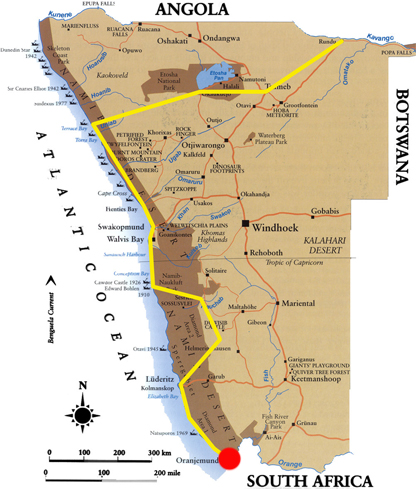AFRICAN WINGS: PART 9: ORANJEMUND
Join us on a 6500km flying adventure through Namibia starting at Rundu on the Angolan border and ending at Oranjemund; the quirky mining town of the Sperrgebiet
We reached the Luderitz airfield to be treated to a 35km wind that was throwing sand at us in dense sheets. This reduced visibility severely and made us quite uneasy about departing Luderitz.
An pilot experienced in local weather conditions at the airport advised us to take off on a secondary airfield facing into the wind. We were airborne in about 10 meters and banked sharply with the wind. There is nothing like a little adrenaline first thing in the morning to get the blood pumping.
 |
| The lonesome shores of the Sperrgebiet |
A friend of ours had warned us that the Sperrgebiet flight between Luderitz and Oranjemund is one the loneliest you will ever make and he was so right. The Sperrgebiet is a truly inhospitable coastline that openly exudes hostility. Old abandoned mining villages, factories and ship wrecks dot the coast and only serve to enhance a deep feeling of isolation.
While flying along the Sperrgebiet you can’t help but think how obscene it is that so much land can be owned by one company......
The Sperrgebiet (German, meaning "Prohibited Area") is a diamond mining area which spans the Atlantic Ocean-facing coast from Oranjemund on the border with South Africa, to around 72 km north of Lüderitz - its total area is around 26,000 km² and makes up three percent of Namibia's land mass. Members of the public are banned from entering most of the area.
The diamond industry has been a double-edged sword in the history of the Sperrgebiet mainly due to its exclusion policy; it has left the park both scarred but spared of over-use. Inland, the habitat has remained largely untouched and pristine, but the coastal areas, where the diamonds occur, have suffered considerable damage.
 |
| Plum Pudding Island |
Situated about 600m off the Sperrgebiet coastline, Plumpudding Island is a tiny island of less than 1 ha. Currently all that inhabits the island are African penguins, Bank Cormorants, Crowned Cormorants, Cape Comorants, Kelp Gulls and Swift Terns. Despite the proximity to Sinclair Island, no seals frequent Plumpudding Island.
Sinclair Island is the southernmost important seabird island in Namibia. Sealing was an important activity on Sinclair Island until the early 1980s. A total of 235 000 seal pups were harvested from the island since the beginning of the 20th century, an average of 3 500 pups per year.
Lukas, whom we had shared oysters with the night before had given us the coordinates of a ship he had lost at sea that had washed up on the forbidden shores of the Sperrgebiet. Nothing that touches these shores is allowed to be recovered and has to be left there – we found Lukas’s ship broken in two on an empty beach
 |
| Lukas's ship broken in two on the savage shores of the Sperrgebiet |
The air temperature was around 10 degrees and the turbulence was decidedly unpleasant. Needless to say we were very glad to get back onto terra firma at Oranjemund.
 |
| Where the mighty Orange River meets the Atlantic |
We had to apply for a security clearance for Oranjemund a week or so before our arrival which Tom’s guesthouse arranged for us. As there was no hangar available we tied EZP down on a piece of gravel next to the apron and headed off to the guesthouse. We can completely recommend Tom’s guesthouse; their hospitality is enormous and they really went out of their way to accommodate us.
As we drove into Oranjemund we were greeted by a huge sign stating that “diamond theft benefits nobody” and were then treated to some stories about the numerous and inventive ways people have tried to steal diamonds out of the restricted area including cross bow and carrier pigeon. Our favourite story was of a mine worker that was searched each and every day as he left the forbidden area, the officials were so focused on finding diamonds that they didn’t realise he walked out with a wheelbarrow every day for years.
Oranjemund is a town owned and run entirely by De Beers and has a bit of a big brother feel to it. All 3000 people living in the town are employed by De Beers, there is no crime, there is no poverty, Oryx walk in the streets and everyone seems very proud to be living there. We had an average lunch alone in the enormous dining hall called the Pink Flamingo which I am sure in its heyday must have been very grand but decided to rather eat dinner back at the guesthouse with some food we bought at Woolworths (yes – incredibly there is a Woolworths in Oranjemund) It was a quirky place to spend an evening, but we enjoyed it thoroughly. For more information on Oranjemund please visit: http://www.oranjemundonline.com/
The next morning the aerie was covered in a thin layer of ice. Unbeknownst to us Jabiru batteries don’t do well in the cold and tend to need a jump start to get going again. The airport officials and Jessie from Tom's guesthouse were exceptionally helpful and seemed to enjoy the unusual sight of a Toyota jump starting an aerie!
 |
| Getting a jump-start on the Oranjemund airfield |










Cool stuff. I checked out Google Earth and saw some of the places you visited. You're right, the coast looks bad.
ReplyDeleteCool and that i have a tremendous proposal: How Much House Renovation cost to gut and renovate a house
ReplyDelete